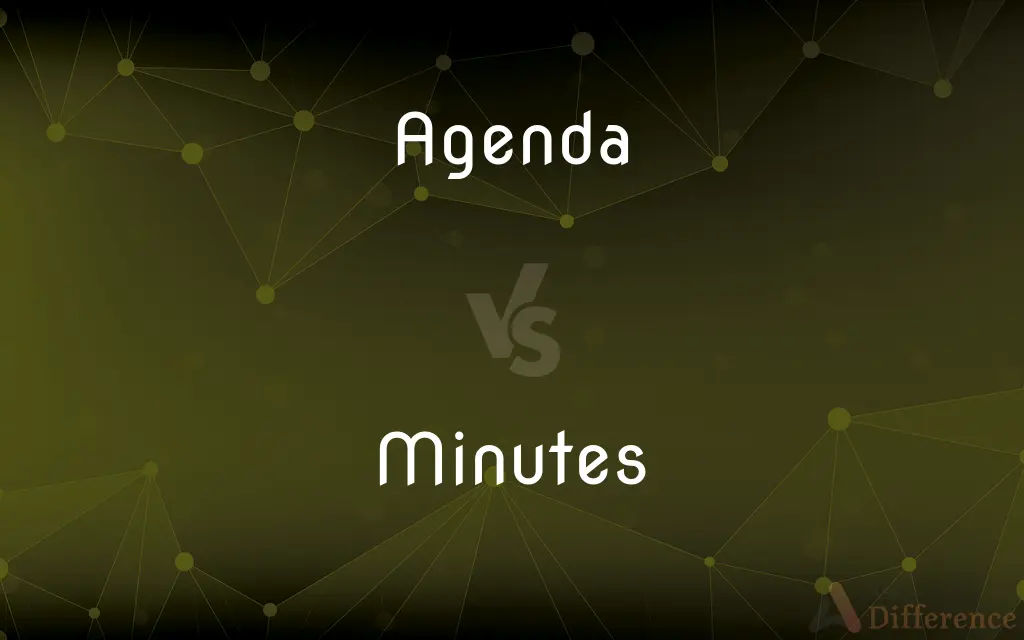Agenda vs. Minutes — What's the Difference?
By Maham Liaqat & Fiza Rafique — Updated on March 16, 2024
Agendas outline topics to be discussed in a meeting, while minutes record what actually happened during the meeting.

Difference Between Agenda and Minutes
Table of Contents
ADVERTISEMENT
Key Differences
Agendas are prepared before a meeting and list the topics to be discussed, providing a structure and ensuring that important points are covered. Minutes, on the other hand, are created during or after the meeting to document the discussions, decisions made, and actions to be taken, serving as an official record.
An agenda is typically distributed in advance to participants, allowing them to prepare for the meeting, contribute effectively, and ensure their concerns are addressed. Minutes, whereas, are circulated after the meeting to all attendees and possibly to other stakeholders, to inform them of the meeting's outcomes and any actions they may need to take.
The preparation of an agenda involves collaboration among meeting organizers and possibly participants, to prioritize topics and allocate time effectively. The preparation of minutes requires attention to detail and accuracy, capturing the essence of discussions, votes, and agreements without unnecessary detail.
Agendas often include a list of items with allocated times, names of presenters or discussion leaders, and sometimes pre-reading materials or questions for consideration. Minutes include the date, time, and place of the meeting, a list of attendees, a summary of each agenda item discussed, decisions made, and action items with assigned responsibilities.
While the agenda aims to guide the meeting's flow and focus, the minutes aim to ensure accountability and follow-through by documenting what was agreed upon, actions to be taken, and by whom. Both are essential for effective meeting management and organizational communication.
ADVERTISEMENT
Comparison Chart
Purpose
Outline topics for discussion
Record discussions and decisions
Timing
Prepared before the meeting
Created during or after the meeting
Content
Topics to be discussed, presenter names
Summary of discussions, decisions, actions
Distribution
Before the meeting to participants
After the meeting to attendees and stakeholders
Key Objective
Ensure meeting structure and efficiency
Provide an official record of the meeting
Compare with Definitions
Agenda
Involves selecting and prioritizing topics for discussion.
The team leader prepared the agenda, ensuring all critical issues were included.
Minutes
Shared with meeting attendees and relevant stakeholders afterward.
The finalized minutes were emailed to all team members for their records.
Agenda
Often includes topics, time allocations, and presenter names.
The agenda listed each topic along with the name of the person leading the discussion.
Minutes
The official written record of what occurred during a meeting.
The secretary was responsible for drafting the minutes immediately following the meeting.
Agenda
Guides the meeting's discussions and structure.
The agenda helped keep the meeting focused and on schedule.
Minutes
Requires detailed note-taking and summarization skills.
Taking minutes involved noting down key points and decisions made during the meeting.
Agenda
A list of items to be discussed or acted upon, prepared before meetings.
The committee reviewed the agenda for the upcoming meeting to add a new discussion topic.
Minutes
Includes attendees, a summary of discussion points, decisions, and action items.
The minutes outlined who was assigned to each action item and their deadlines.
Agenda
Sent to participants before the meeting for preparation.
The agenda was distributed a week in advance to allow everyone to prepare.
Minutes
Documents and tracks decisions, actions, and attendees.
The minutes served as a reference for team members who were unable to attend.
Agenda
A list of things to be discussed in a meeting.
Minutes
Minutes, also known as minutes of meeting (abbreviation MoM), protocols or, informally, notes, are the instant written record of a meeting or hearing. They typically describe the events of the meeting and may include a list of attendees, a statement of the issues considered by the participants, and related responses or decisions for the issues.
Agenda
A program of things to be done or considered
"King's broadening of the civil rights agenda to include issues of class, income, and employment" (James Carroll).
Minutes
A unit of time equal to one sixtieth of an hour, or 60 seconds.
Agenda
(Informal) A usually unstated underlying motive
"Everyone has an agenda, whether he or she is honest about it or not" (Ted Nordhaus and Michael Shellenberger).
Minutes
A unit of angular measurement equal to one sixtieth of a degree, or 60 seconds. Also called arcminute, minute of arc.
Agenda
A datebook
Bought a leather-bound agenda.
Minutes
A measure of the distance one can cover in a minute
Lives ten minutes from school.
Agenda
A plural of agendum.
Minutes
A short interval of time; moment.
Agenda
A temporally organized plan for matters to be attended to.
Minutes
A specific point in time
Stop that this minute!.
Agenda
A list of matters to be taken up (as at a meeting).
Minutes
A note or summary covering points to be remembered; a memorandum.
Agenda
A notebook used to organize and maintain such plans or lists, an agenda book, an agenda planner.
Minutes
Minutes An official record of the proceedings of a meeting.
Agenda
An ulterior motive.
Minutes
To record in a memorandum or the minutes of a meeting.
Agenda
(obsolete) A ritual.
Minutes
Plural of minute
Agenda
Plural of agendum
Minutes
The official notes kept during a meeting.
Agenda
A temporally organized plan for matters to be attended to.
Minutes
A written account of what transpired at a meeting
Agenda
A list of matters to be discussed (as at a meeting).
Agenda
A motive or set of goals; as, to have one's own agenda;
Agenda
A temporally organized plan for matters to be attended to
Agenda
A list of matters to be taken up (as at a meeting)
Common Curiosities
How do agendas and minutes complement each other?
Agendas provide a structure for the meeting, while minutes ensure that the discussions and outcomes are recorded and actionable.
Who prepares the agenda and minutes?
The meeting organizer typically prepares the agenda, and a designated secretary or participant prepares the minutes.
Why is it important to distribute the agenda before the meeting?
Distributing the agenda in advance allows participants to prepare, ensuring a more efficient and focused meeting.
What is an agenda?
An agenda is a document outlining the topics to be discussed in a meeting, prepared in advance to guide the meeting's structure.
What information is typically included in the minutes?
Minutes include the date, participants, a summary of discussions, decisions made, and assigned action items.
Can the agenda be changed during the meeting?
Yes, the agenda can be modified during the meeting with the consent of the participants to address emerging issues or priorities.
Can electronic tools be used for agendas and minutes?
Yes, electronic tools and software can streamline the preparation, distribution, and archiving of agendas and minutes.
What are minutes?
Minutes are the official record of the proceedings of a meeting, documenting discussions, decisions, and actions.
Are minutes legally binding?
Minutes can serve as a legal record of decisions and actions taken by a group, especially in formal organizations or boards.
What is the role of the chairperson in relation to the agenda and minutes?
The chairperson approves the agenda, guides the meeting according to it, and often plays a role in reviewing and finalizing the minutes.
How detailed should minutes be?
Minutes should capture key points, decisions, and actions, without unnecessary detail, focusing on outcomes and assignments.
How soon after a meeting should the minutes be distributed?
Minutes should be distributed as soon as possible after the meeting, ideally within a few days, to ensure clarity and follow-up on actions.
What happens if an item on the agenda is not discussed?
Items not discussed may be deferred to the next meeting or addressed through other channels, depending on their urgency and importance.
What if there is a discrepancy between the agenda and the minutes?
Discrepancies should be addressed and corrected to reflect what was actually discussed and decided during the meeting, ensuring transparency and accuracy.
Should minutes be approved?
Yes, minutes are usually reviewed and approved at the beginning of the next meeting to ensure accuracy and consensus.
Share Your Discovery

Previous Comparison
Backgammon vs. Gammon
Next Comparison
Inflection vs. CaseAuthor Spotlight
Written by
Maham LiaqatCo-written by
Fiza RafiqueFiza Rafique is a skilled content writer at AskDifference.com, where she meticulously refines and enhances written pieces. Drawing from her vast editorial expertise, Fiza ensures clarity, accuracy, and precision in every article. Passionate about language, she continually seeks to elevate the quality of content for readers worldwide.














































